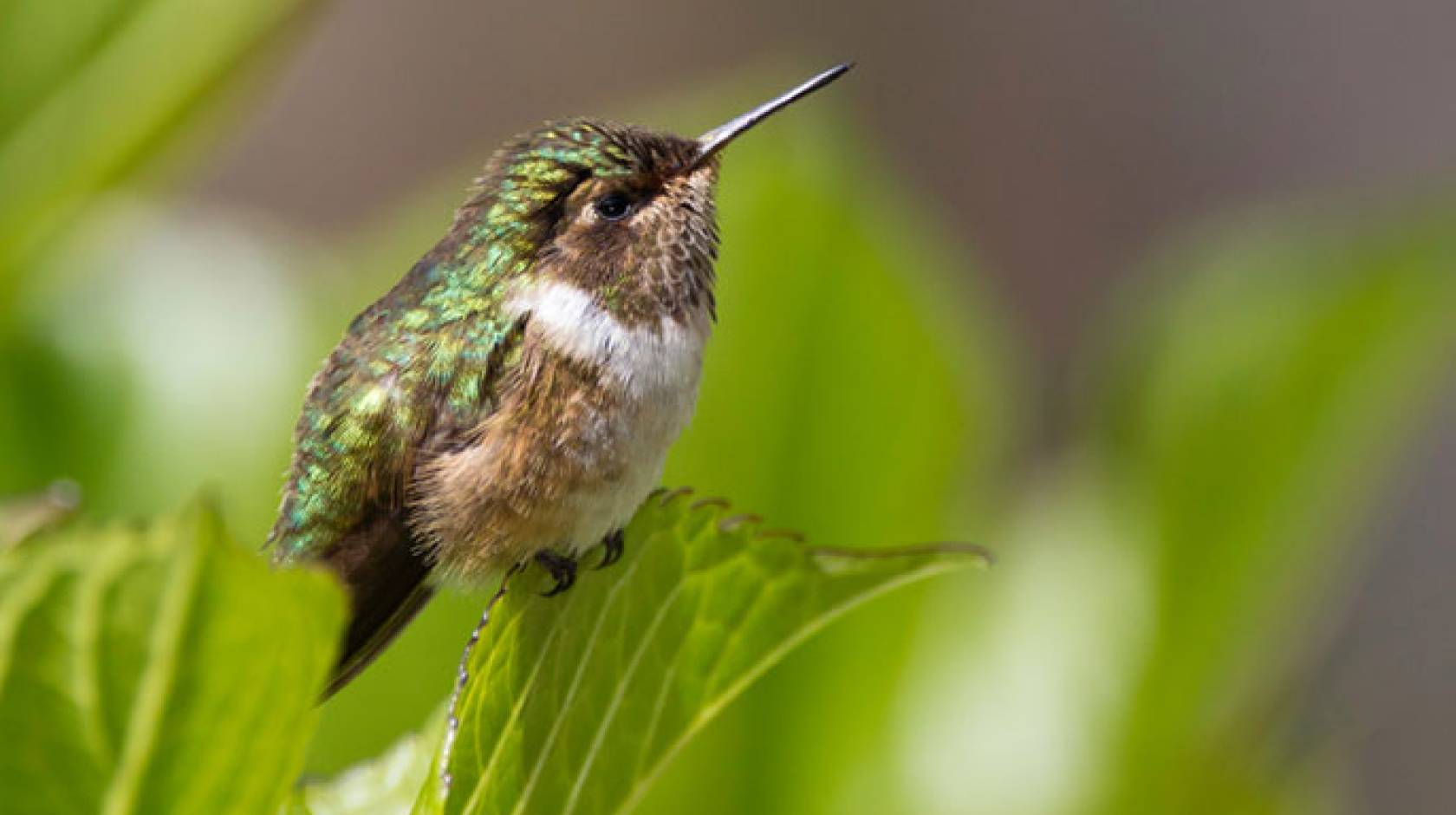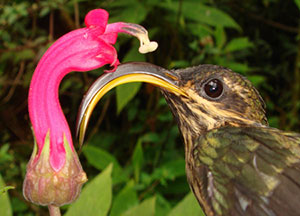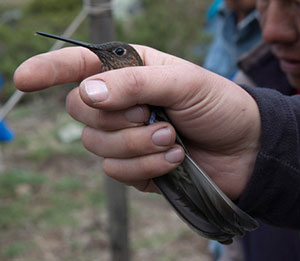Robert Sanders, UC Berkeley

A newly constructed family tree of the hummingbirds, published today in the journal Current Biology, tells a story of a unique group of birds that originated in Europe, passed through Asia and North America, and ultimately found its Garden of Eden in South America 22 million years ago.
These early hummingbirds spread rapidly across the South American continent, evolved iridescent colors — various groups are known today as brilliants, topazes, emeralds and gems — diversified into more than 140 new species in the rising Andes, jumped water gaps to invade North America and the Caribbean, and continue to generate new species today.
“Our study provides a much clearer picture regarding how and when hummingbirds came to be distributed where they are today,” said lead author Jimmy McGuire, a UC Berkeley associate professor of integrative biology and curator of herpetology (reptiles and amphibians) in the campus’s Museum of Vertebrate Zoology.
There are now 338 recognized hummingbird species, but that number could double in the next several million years, according to the study’s authors, who come from UC Berkeley, Louisiana State University and the universities of New Mexico, Michigan and British Columbia.
“We are not close to being at the maximum number of hummingbird species,” McGuire said. “If humans weren’t around, they would just continue on their merry way, evolving new species over time.”
Hummingbird ancestors arose in Eurasia 42 million years ago

The Buff-tailed Sicklebill (Eutoxeres condamini), a hermit hummingbird, beside one of the flowers to which they are specialized, showing how the flower and recurved bill have co-evolved.
Credit: Christopher Witt/University of New Mexico
For more than 12 years, McGuire and his colleagues collected DNA data from 451 birds representing 284 species of hummingbirds and their closest relatives, ultimately sequencing six nuclear and mitochondrial genes. They used the data to arrange the living groups in a family tree, and concluded that the branch leading to modern hummingbirds arose about 42 million years ago when they split from their sister group, the swifts and treeswifts. This probably happened in Europe or Asia, where hummingbird-like fossils have been found dating from 28-34 million years ago.
Somehow, he said, hummingbirds found their way to South America, probably via Asia and a land bridge across the Bering Strait to Alaska. They left no survivors in their ancestral lands, but once they hit South America about 22 million years ago, they quickly expanded into new ecological niches and evolved new species represented by nine distinct groups known today as topazes, hermits, mangoes, brilliants, coquettes, mountain gems, bees, emeralds, and the single-species group Patagona (the Giant Hummingbird, Patagona gigas).
About 12 million years ago, the common ancestor of the bee and mountain gem hummingbird groups made the jump into North America, which at the time was still separated from South America by a few hundred miles of water. Once these hummingbirds had “prepared the ground” by initiating co-evolution with North American plants, McGuire said, they were later followed several times by other hummingbird lineages, including representatives of the mangoes and emeralds, and then by many more species when the Isthmus of Panama formed connecting South and North America about 4 million years ago.
About 5 million years ago, hummingbirds invaded the Caribbean, and did so five more times since. One of these groups, the bee hummingbirds, which originated in North America, participated in the Caribbean invasion, and even re-colonized South America alongside existing lineages. This group experienced the highest diversification rates of any hummingbird group — 15 times that of the lowest, the topazes — which is on a par with that of classic examples of rapid adaptation to a new environment (adaptive radiation).
The genetic analysis shows that the diversity of hummingbirds continues to rise today, with the origination rate of new species exceeding extinction rates. And despite the fact that they feed primarily on nectar and tiny insects, some places contain more than 25 species in the same geographic area.
“When it comes to vertebrate animals, hummingbirds are about as diverse as they come,” he said.
From herps to hummingbirds

A Giant Hummingbird (Patagona gigas), the largest of the hummingbirds, photographed in Peru. Patagona, one of the nine principal lineages of hummingbirds, is found between sea level and 15,700 feet elevation in the Andes.
Credit: Jimmy McGuire/UC Berkeley
McGuire, a herpetologist whose main interest is the evolution of reptile and amphibian diversity in Southeast Asia, became interested in hummingbird flight by accident while a graduate student at the University of Texas at Austin. While there he collaborated with Robert Dudley, an expert on hummingbird flight and now a fellow UC Berkeley professor of integrative biology, and Dudley’s student, Doug Altshuler, now at the University of British Columbia. They wanted to understand how hummingbirds are able to live at high elevations, including at over 15,000 feet in the Andes Mountains, despite the reduced air density, which makes flying harder. Such a study required, however, that they understand how the various species are related, and McGuire volunteered to do a genetic analysis to construct a phylogeny (the equivalent of a genealogy but for species).
One unanswered question, he said, is how hummingbirds got a toehold in South America at all, since today they are dependent on plants that coevolved with them and developed unique feeding adaptations.
“It is really difficult to imagine how it started, since hummingbirds are involved in this coevolutionary process with plants that has led to specializations we typically associate with hummingbird plants, such as tubular, often red flowers, with dilute nectar,” he said. “They drive the evolution of their own ecosystem. The evolution of hummingbirds has profoundly affected the evolution of the New World flora via codiversification.”
McGuire hopes to continue hummingbird studies with his colleagues, exploring how they’ve adapted to a diverse variety of ecological niches and, in particular, how they tolerate reduced oxygen availability at high elevations.
“Everything about hummingbirds is extreme,” said McGuire, who initiated work on the current phylogenetic analysis as an assistant professor at Louisiana State University before joining the UC Berkeley faculty in 2003. “They have this incredible hovering flight, with wing beat frequencies of 60 times per second, which is nuts. They have the highest metabolic rate for their size of any vertebrate; they are little machines that run on oxygen at a high rate. They also have the largest hippocampal formation in the brain of any bird, which is tied to spatial learning, presumably because they visit the same flower clusters over and over again, and must remember where and when they most recently slurped the nectar from individual flowers. It is amazing that evolution can take an animal to such extremes.”
In addition to Dudley and Altshuler, other coauthors are Christopher C. Witt of the University of New Mexico, Albuquerque; J. V. Remsen, Jr., of Louisiana State University, Baton Rouge; Ammon Corl of UC Berkeley; and Daniel L. Rabosky of the University of Michigan, Ann Arbor.
The work was funded by the National Science Foundation (DEB 0330750, 0543556, 1146491).

